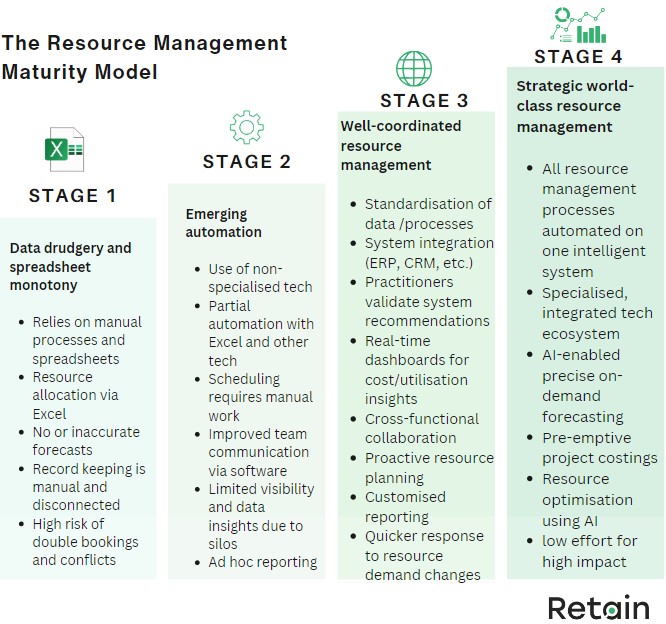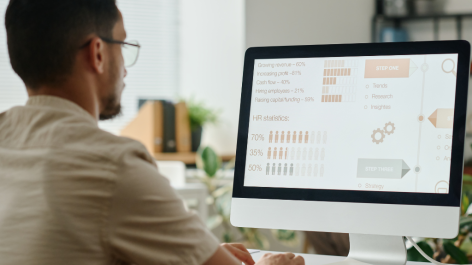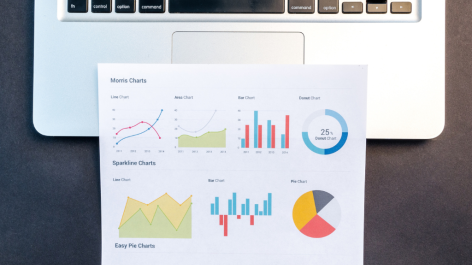Best practice resource management is a journey. At the starting point, it tends to be manual and reactive, using tools like spreadsheets and basic tools. But with the use of the right tech, you can fine-tune resource allocation and predict demand.
To help you see which stage of resource management maturity your firm fits in, we will explore the four stages of the Resource Management Maturity Model:
- 1. Manual resource management
- 2. Basic resource management
- 3. Connected resource management
- 4. Strategic resource management
By understanding these four stages, you'll be able to pinpoint where you are right now and plot a course to move towards best practices. And the great news is, each step forward brings you more benefits—better use of resources, lower costs, improved project delivery, and a smart approach to strategy.
Let’s get into it.
Introducing the Resource Management Maturity Model
When a company's resource management tasks grow beyond a certain point, things can get pretty tricky to handle.
But here's the silver lining: thanks to technology, tasks that used to require lots of manual work can now be automated. So, instead of getting tangled in spreadsheets, you can let technology do the heavy lifting.
What is resource management maturity?
The Resource Management Maturity Model is a handy tool that gives you a clear view of where your firm stands in terms of resource management. It offers a straightforward way to understand your current stage and outlines the steps to progress further. It's all about helping you improve and move towards best practices in a straightforward and transparent way.

The model has four stages that represent levels of increasing maturity:
- 1. Manual resource management
- 2. Basic resource management
- 3. Connected resource management
- 4. Strategic resource management
With this model as your guide, you can easily assess your current abilities and spot the practical steps needed to level up. And as we’ve touched on, the beauty of moving up the stages are the benefits unlocked: think better use of resources, cost savings, smoother project delivery, and more agility in your strategy.
Moving through these stages means you're turning resource management from a hands-on task to an optimised, strategic function.
To help you work out where your firm fits, in the next sections, we will explore the four stages of the model in more detail.
1. Manual Resource Management 📝
At the starting line, resource management is pretty hands-on. It's all about manual processes, spreadsheets, and email exchanges. But let's be honest, it can feel like you're stuck in a never-ending cycle of data overload and death by spreadsheets.
🔹Resource allocation is done through basic Excel spreadsheets. This relies heavily on manual work by resource managers and project teams.
🔹There are no forecasting capabilities or manual forecasts are inaccurate. This means resource managers cannot predict upcoming resource needs.
🔹Everything is recorded manually, often across disconnected spreadsheets. This creates an unreliable audit trail and lack of a single source of truth.
🔹There is a high risk of double bookings and resource conflicts, leading to reactive firefighting.
🔹Without forecasting, resource managers can’t be proactive. They can only respond reactively to urgent resource gaps or conflicts.
When you're relying on this manual approach, resource management data ends up cooped up in its own little world, processes feel like a broken record on repeat, and problems only get attention after they've popped up. It's clear that it's time to level up to at least basic resource management software, to bring a bit of transparency and control into the scene.
2. Basic Resource Management ⚙️
This is where you start dabbling with some basic software and get your first taste of automation. But let's be real, it's like dipping your toes in the water. Disconnected processes and manual work is still the name of the game.
🔹There is usually a patchwork of Excel spreadsheets and non-specialised technology that only automates parts of the process.
🔹Scheduling and resource allocation still requires extensive manual work. Resource managers must input and update data.
🔹Communication between teams is improved through notifications and alerts, but there’s still a lack of cross-functional comms.
🔹There is increased visibility into resources compared to only manual methods. But firms are still reliant on basic or non-specialised technology.
🔹Data and insights are limited as information sits in organisational silos.
At this stage, while you’ve waved goodbye to strictly manual methods, resource management is still a bit like playing catch-up, addressing things as they come up. And although the tech is definitely a step forward, it's not providing the full visibility or the complete automation that's really needed for top-notch strategic resource planning.
3. Connected Resource Management 🌐
At this enhanced stage, resource management becomes a smooth operation, all thanks to the power of integration and standardisation.
🔹Resource management data and processes are standardised across the organisation. This enables a single source of truth.
🔹Systems are integrated, connecting resource management software with ERP, CRM, project management and other platforms.
🔹Practitioners validate and confirm recommendations made by the system for resource allocation and scheduling.
🔹Real-time dashboards provide insights into resource utilisation, costs and emerging data trends.
At this stage, you gain a complete view of the entire resource management process. It's fully automated, but human insight still plays a crucial role in ensuring the best results.
Making it to this level is a big win for resource management efficiency and optimisation. But for firms aiming to unlock even more strategic value, the next stage is a game changer with its advanced capabilities.
4. Strategic Resource Management 📈
At this top-tier stage, firms adopt to strategic resource management that's world-class, thanks to the full automation of resource management software and the smart optimisation power of AI.
🔹All resource management processes are automated on a single, intelligent platform powered by AI.
🔹The technology ecosystem is specialised for professional services and integrates seamlessly with other systems.
🔹Advanced capabilities enable precise forecasting of on-demand resource needs.
🔹Projects can be pre-emptively costed based on forecasts before work begins.
🔹Algorithms and predictive analytics optimise resource allocation and utilisation.
🔹Operations teams expend minimal manual effort to get maximum impact.
When you reach this level, resource management isn't just running on autopilot, it's also fine-tuned to perfection. And with strategic approaches, you can model and prep for different scenarios, aligning resources flexibly to meet business goals.
The competitive edge you unlock at this stage boosts profitability, efficiency, and agility.
How do you achieve this level of maturity? Request a no-obligation consultation to see what a good resource management process can look like for your company. Book a demo.
Evaluating your resource management maturity
Dipping into the Resource Management Maturity Model gives companies a solid framework for giving their current capabilities a good, honest look.
So, if you’re ready to put your resource management under the microscope, here are some questions to get you started:
☑️Is resource management still driven by manual processes and spreadsheets? Or is data integrated across systems?
☑️Is resource forecasting and allocation reactive or optimised using AI-powered algorithms?
☑️Does the software provide complete visibility or only cover parts of the process?
☑️Can you run scenarios and simulations for strategic planning? Or is scheduling done manually?
☑️Are there gaps between systems causing information silos? Or is there a single source of truth?
☑️What percentage of resource management work is still manual? What is automated?
☑️How quickly can your firm adapt to changing resource needs and client demands?
By tackling these questions, you'll get a clear picture of where your company fits in the maturity curve. Knowing where you are now is a must for figuring out the step-by-step journey to the next level.
For instance, moving from manual spreadsheets to the right resource management software delivers a huge leap in efficiency. Integrating systems and applying AI optimisation unlocks even further strategic value.
Moving up the resource management maturity curve
Once you have a clear idea of your firm's current resource management maturity, the next step is crafting a roadmap to reach the next stage.
Here are some handy tips to help you along the way:
🔹Get the execs on board. Gain executive buy-in for change by quantifying current inefficiencies and presenting the maturity model.
🔹Tackle the basics first. Start with foundational issues first, such as integrating systems, and eliminating spreadsheet chaos.
🔹Lean on the right tech: Introduce the right resource management software, which can scale and grow with you.
🔹Keep teams in the loop: Involve operations teams closely in each stage to drive adoption.
🔹Offer training: Provide proper training and support to help employees adjust to new processes.
🔹Keep an eye on metrics: Measure metrics like resource utilisation and project margins to quantify improvements.
🔹Celebrate small wins: No matter how big or small to maintain momentum for digital transformation.
With a thoughtful approach, you can unlock incredible gains in efficiency, cost savings, and strategic advantages. But remember, it's all about commitment from everyone in the organisation.
We’ve created the maturity model as your roadmap. Every step you take towards the next stage is an investment that brings outsized long-term rewards.
Final key takeaways
Here are some key points to remember:
💡The Resource Management Maturity Model comprises four stages: Manual, Basic, Connected, and Strategic. Knowing your current stage is crucial for planning your progress to the next level.(Plus you can skip stages with the right tech)
💡Moving to higher stages brings great benefits, such as increased efficiency, cost savings, and a competitive edge. But remember, this progress requires commitment from executives, support from employees, and a carefully planned approach.
💡Investing in advancing your resource management maturity offers significant long-term benefits.
The model gives your firm a clear framework to benchmark capabilities and transform resource management from a manual task to an optimised, strategic function.
And one more thing: with the latest automation and AI technologies, resource management can shift from a basic operational task to a function that truly drives strategic value.
Ready to level up to strategic resource management? With Retain's resource management software, you can get the capabilities of the highest maturity stage right from the get-go. Find out more or book a demo.


